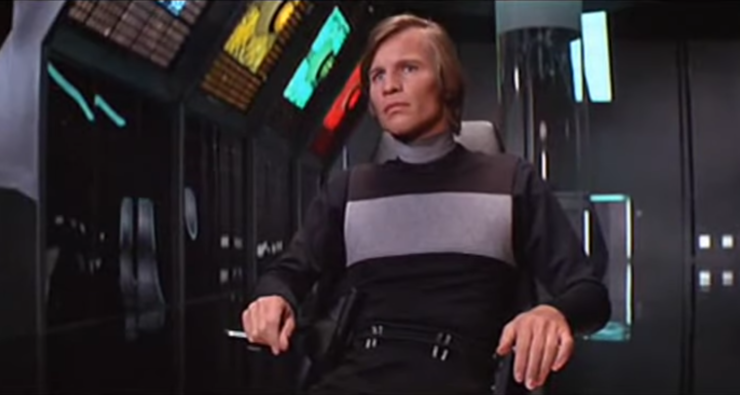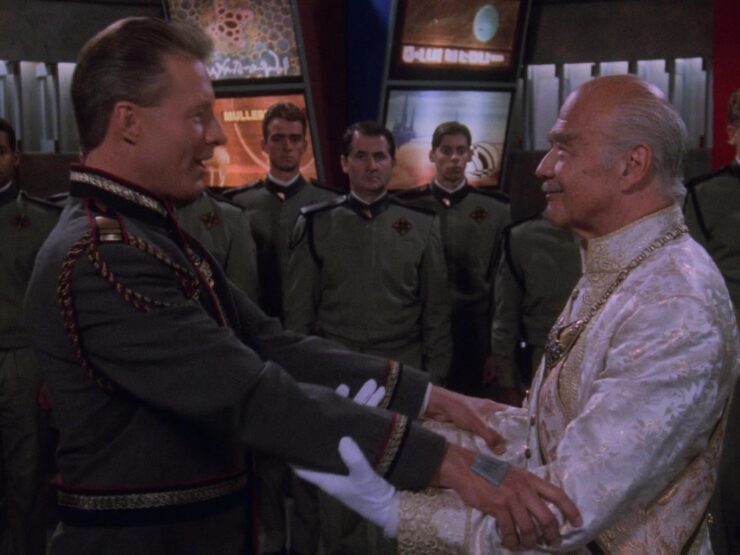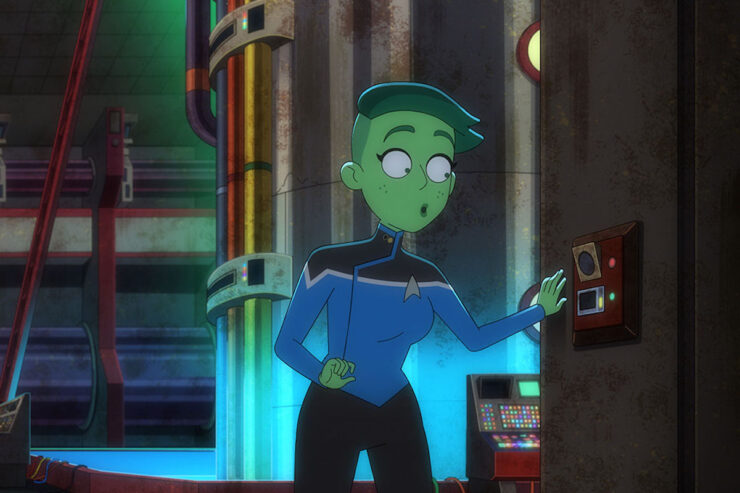I came into my second viewing of Logan’s Run the same way I went into my first: With an open mind and a hopeful heart. This may seem paradoxical, given that my first exposure to the film upon its 1976 opening did not end well—and by “not end well,” I mean me walking past the line waiting to get into the next show and screaming, “YOU’RE WASTING YOUR MONEY!”
Still, I’m not quite the mega-passionate, hot-headed youth I was in my twenties (I’m now a mega-passionate, hot-headed ol’ fart). And the ensuing forty-five years have seen Logan’s Run, if not quite rise to the level of a genre classic, at least accrue enough affection to be regarded as a notable entry in the field. Which raised a concern: I’d originally proposed examining the flaws of Logan’s Run, but with the passage of time, would I see a different film? Honestly, if maturity (such as it is) allowed me to better appreciate what I had denigrated before, I would not have hesitated to contact my editor and say, “I’m sorry, I’ve made a horrible mistake. The premise I pitched to you is completely wrong—let’s just forget the whole thing.”
The fact that you’re reading this article serves as testament that what I felt about the movie then is just as applicable now. Let’s discuss.
Mind you, it isn’t as if the basic plot isn’t compelling. Some two hundred years into the future, ecological disaster has seen a meager handful of humanity retreat to domed biospheres. There, under the care of an omnipresent computer system, people live a carefree, hedonistic lifestyle. But paradise under limited resources comes with a price: No one lives past the age of thirty. When time runs out and the glowing crystal in the palm of your left hand turns black, you have two choices: Either report to Carousel, an anti-grav arena where those whose time is up can attempt to snag a rare opportunity at “renewal;” or literally run for your life, and hope that your path does not cross that of a Sandman, the armed, ruthless enforcers of the system.
It is the misfortune of one Sandman, Logan—played by Michael York—to have terminated a runner who was carrying an Ankh amulet, the symbol for Sanctuary, a mythic—and illegal—refuge for runners located beyond the city’s protective domes. The computer system, discovering Logan in possession of the trinket, accelerates his crystal to its termination point, and charges him with going undercover as a runner in order to discover the location of Sanctuary. Filled with growing doubts about the system he has spent his lifetime serving, Logan joins forces with Jessica (Jenny Agutter)—possessor of another Ankh symbol—and, while being pursued by former colleague Francis (Richard Jordan), must contend with 25-year-old juvenile delinquents, homicidal plastic surgeons, an insane food-processing robot, and Peter Ustinov in order to discover the secret of Sanctuary, and the truth about his dystopic Shangri-La.
Give director Michael Anderson his due: a veteran of such films as Around the World in 80 Days and The Quiller Memorandum, he does know how to stage a moment. His envisioning of Carousel is suitably strange and unsettling—the masked participants floating up from a bowl-shaped turntable toward a glowing white crystal, only to perish before reaching their goal (although the event is less “fiery,” as described in the opening title crawl, as it is “explody”).
He knows how to deploy stillness for dramatic effect, as when Logan waits while a scanner lingers over the Ankh, the Sandman’s anxiety accentuated by the quiet clicking of computer relays in the background. He gives his mad food-processing robot, Box—played by Roscoe Lee Browne—more motivation for his murderous intent beyond the general sadism exhibited by the same character in William F. Nolan and George Clayton Johnson’s original novel. And by making Francis a close colleague of Logan’s, he grants the rival Sandman some emotional grounding that elevates him beyond just being the indomitable Javert of the novel.
Some choices, though, undercut the final effect. The film’s termination date has been aged-up from the novel’s twenty to thirty—perhaps necessary for the sake of getting popular actors who could handle their roles, but also blunting the notion of lives extinguished too soon (to be fair, Nolan and Johnson also struggled with portraying teenagers in the book—too often their characters’ speech and actions would be as fitting for forty-five-year-olds as fifteen). The authors managed to sneak in hints that Paradise is beginning to fray around the edges, a more subtle indication of corruption than the film’s evil computer. And instead of having a machine rob Logan of his remaining years, the novel’s protagonist has naturally aged toward his black crystal and, still the committed Sandman, begins his pursuit of Sanctuary as a way of going out with the glory of having single-handedly discovered and invoked the destruction of the refuge. His change of heart evolves gradually from his interactions with Jessica and the struggles they go through, rather than being prematurely triggered at the story’s start, as happens in the film.
But that change—from the novel’s “We can be more than the world we were born into” to the film’s “The system is rigged!”—can be easily comprehended in context, considering the time of Logan’s Run’s creation. The years surrounding 1976 marked the end of one of the most tumultuous periods in American history, seeing the waging and ignominious resolution of a highly unpopular war, the resignation in disgrace of a corrupt president, and a vast, cultural shift in which Baby Boomers en masse rejected the values of the post-war period and sought to rebuild society on their own terms (that they were not all that successful is a topic for another time). Cynicism, fatalism, and an overall mistrust of entrenched power were the orders of the day. That attitude seeped irrevocably into popular media, and while science fiction had already begun to veer away from tales of bug-eyed monsters and slinky, alien seductresses prior to 1968, that year’s release of 2001: A Space Odyssey and Planet of the Apes triggered a massive shift in the genre, allowing it to encapsulate a whole raft of contemporary anxieties. From the helpless paranoia of Colossus: The Forbin Project to the ecological despair of Silent Running to the class critique of Soylent Green, science fiction became the conduit by which cultural tensions and controversies could be spotlighted and discussed.
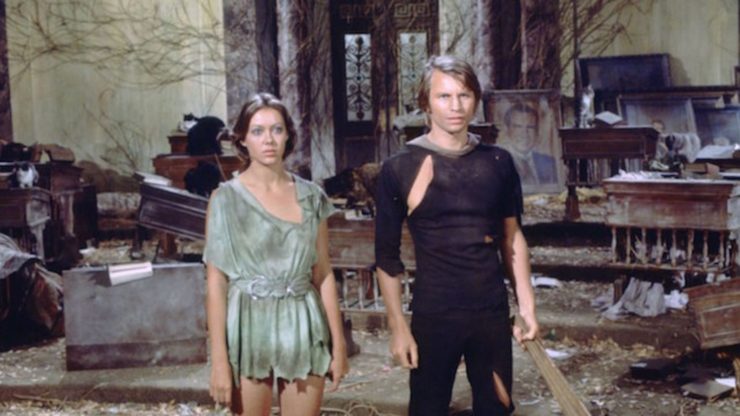
The problem for Logan’s Run, though, was that the movie was coming at the tail end of this cycle. There had been so much hand-wringing over what kind of dreary future was in the offing—even fledgling filmmaker Steven Spielberg had tried his hand at it with “L.A. 2017,” a peculiar episode of the TV show, The Name of the Game, that saw series lead Gene Barry cast forward in time into an environmentally-ravaged Los Angeles—that Run’s list of ominous outcomes felt played out, if not a little silly. The ludicrousness wasn’t helped by the portrayal of a decadent, youthful society (if “pushing thirty” can still be called “youthful”), presented more from the perspective of, “Hey, you kids, get offa my lawn!” than with an actual empathy for youth culture. (Although, to be fair, a moment when Logan summons up a male on his Dial-a-Boink transporter and reacts with not much more than an expression of, “Nah, not tonight,” is remarkably restrained for the time.)
But unlike the Star Trek episode “The Way to Eden,” there may have been more to Run’s invocation of the “kids are the aliens among us” trope than general audiences may have perceived. Concurrent with, and inextricably tied to, the overall societal revolution, Hollywood was going through a revolution of its own. The studios had never quite recovered from the anti-trust suit that lost them control of their movie theaters, and audiences had been steadily declining, the aging proprietors of the dream factories seemingly incapable of conceiving projects that would lure young patrons away from TV and back to the theaters. The jettisoning of the censorious Production Code in favor of the MPAA ratings system was supposed to be a remedy, but instead exacerbated the situation, opening the door to a new generation of filmmakers spawned from film schools and B-movie studios, artists who’d been weened on 16mm cameras and weren’t afraid of shooting on location. The likes of Arthur Penn, Hal Ashby, and Dennis Hopper—working within and without the studio system—weren’t afraid of incorporating explicit gore, frank sexuality, and pure, raw emotional honesty into their works, soundtracked with cuts pulled from popular recording artists rather than lush, studio orchestras. It’s worth considering the possibility that director Anderson (age 56 at the time of Run’s release), screenwriter David Zelag Goodman (46), and producer Saul David (55) were casting a wary eye at the generation of creatives nipping at their heels, and allowing that anxiety to seep into Run’s mise en scene.
One thing’s for sure: Even for the time, the film felt old. Composer Jerry Goldsmith welcomes us into the future with a hackneyed, synthesized thrumming, transitioning into mechanized trilling as we move from an unconvincing exterior flyover of the biodomes to an interior overview of the elaborately modeled—and still unconvincing—miniature cityscape. Art director Dale Hennesy’s main strategy for envisioning the twenty-third century is to take a setting—most notoriously a Texas shopping mall—and accent it with polished chrome and brushed aluminum. There are striking visual moments, such as a glimpse of Box’s victims trapped within ice, and Matthew Yuricich delivers some evocative matte paintings of a flora-overgrown Washington D.C. (which means that the biodomes are located somewhere within the wastelands of…Virginia?). But in the waning years of the 1970s, the look and feel of Logan’s Run reflected a design sense that had already run its course.
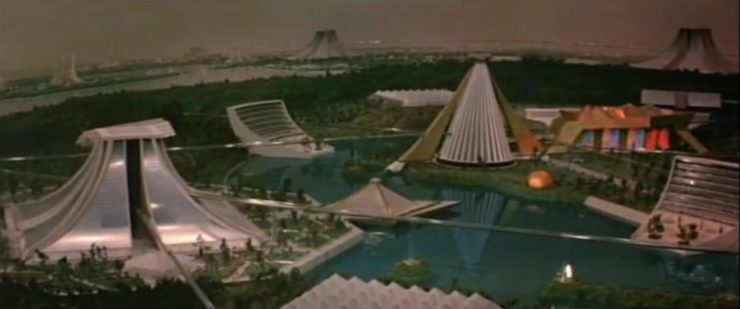
As had this dour subgenre overall: For all of its big-budget lavishness, Logan’s Run’s grim, preachy outlook felt tired. The film did well at the box office, but its lasting impact ironically lay not in its own ideas, but in how a growing dissatisfaction with a played-out form of speculation laid the groundwork for the next revolution in genre film, a quantum shift in the field that many—albeit subconsciously—longed for, but that few at the time could have anticipated.
On May 25, 1977, practically one year to the day of Logan’s Run’s release, Star Wars debuted in theaters in the U.S.
From its very first frames, George Lucas’ space fantasy declared itself the polar opposite of the hectoring, grim speculations Hollywood had been turning out. Instead of a dehumanized, quasi-“futuristic” synthesizer score, audiences were greeted by John Williams’ rousing, orchestral fanfare. The settings eschewed a designer’s fitful prognostication of what a future might look like for something realer, scrappier, more lived-in; the tech felt substantial and credible (so long as you could accept that androids might manifest the personalities of eight-year-old savants or fussy English manservants). And, most of all, it was fun. Lucas—who in another irony made his feature debut with the dystopic THX 1138—scrubbed away the cynical, paranoid pall of ’70s social awareness to create a binary universe of good and evil. He built his story out of a self-aware mashup of swashbuckling adventure, cheesy movie-serial sci-fi, and vague mysticism (echoing, in another ironic turn, the genre-hopping structure of Logan’s Run’s original novel). And he set it all in an indeterminate past (in a galaxy, etc, etc.), absolving the audience from looking fearfully toward the foreboding future, and instead embracing a time perceived as simpler, more innocent (even if reality contradicts that perception).
Buy the Book
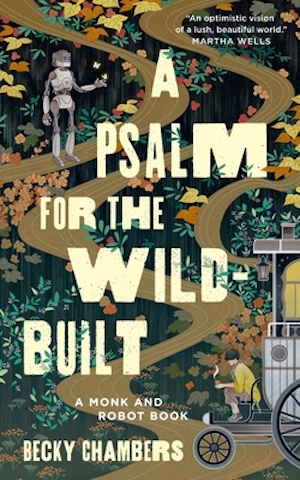

A Psalm for the Wild-Built
And, in the final irony, Star Wars did what Logan’s Run could not: Reinvigorate the mainstream studios by luring back young audiences thought forever lost to the ’70s bad boys of film. Turns out the secret to mainstream success was not in trying to embrace the more cynical, grittier outlook of Scorsese and company, but in jettisoning it completely, injecting B-movie frivolity with A-movie budgets, and offering up films whose intersection with reality was glancing at best. The better filmmakers could inject some gravity into all the action and spectacle, but that would be a side-benefit, not the goal.
And maybe that’s the way it always should have been. The flaw of Logan’s Run was possibly that its principled moral stand rang hollow, motivated by market considerations rather than genuine social concern. I have no doubt the creators of Run invested considerable skill, energy, and heart into their work, but they aimed at the wrong goal, one of trying to ape a cinematic revolution—which, like the youth revolution overall, turned out to be more ephemeral than any of its participants could have imagined—within the confines of a dying system. Over time, the two disciplines would go their separate ways, mainstream film becoming bigger, louder, and more superficial—but not without its own pleasures and occasional deeper meanings—and more thoughtful genre films finding a home in smaller, indie productions, where the likes of a Denis Villaneuve or an Alex Garland have the freedom to delve the nuances of a speculative scenario without the pressure of pulling in a nine-figure box office.
In the end, I’ve come to feel that maybe I’d been a bit too harsh on Logan’s Run, but not completely wrong. It stands as a relic of a time when the titans of film attempted a course correction that their lumbering behemoth of an industry couldn’t quite negotiate. Logan’s Run leapt for something grand, but was pulled back to Earth by the system in which it was borne.
***
So, I know I’m gonna catch Hell from some of you for this. But that’s okay—this is my opinion and I stand by it. If you disagree you have an opportunity to rebut my arguments. The comments section is below—keep it friendly, or at the very least polite, and have at it!
Dan Persons has been knocking about the genre media beat for, oh, a good handful of years, now. He’s presently house critic for the radio show Hour of the Wolf on WBAI 99.5FM in New York, and previously was editor of Cinefantastiqueand Animefantastique, as well as producer of news updates for The Monster Channel. He is also founder of Anime Philadelphia, a program to encourage theatrical screenings of Japanese animation. And you should taste his One Alarm Chili! Wow!










